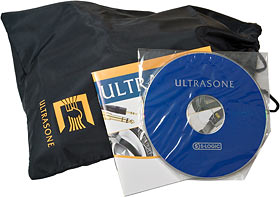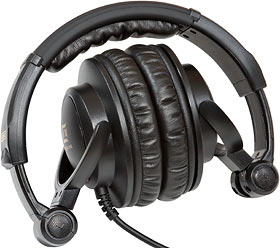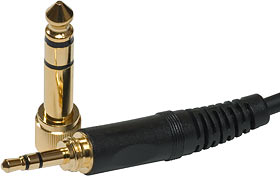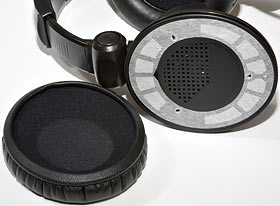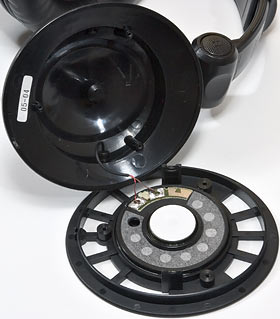
Ultrasone HFI-550 headphones
Review date: 12 March 2005.Last modified 03-Dec-2011.
It is not, generally speaking, a good thing when something printed on the outside of a piece of audio equipment makes reference to its monstrous bass capabilities.
Generally speaking, the best of those products are suspension-warming automotive subwoofers with two-man-lift warnings on the carton. Most of them are boom boxes and mini stereo systems whose frequency response plot looks like a solar tower in profile.
Some of them are headphones.
I was, therefore, less than totally optimistic about Ultrasone's HFI-550 headphones, which have "Beastmaster" - I'm sorry, I'll read that again - "Beatmaster" printed on the top of the headband.
Ultrasone are a German company and don't appear to have quite got the hang of English translation, so their product page for the HFI-550s, like various other pages on their site, has the fractured feel of any number of manufacturers of cheap and cheerful Taiwanese tat.
Unlike most gear with a UltraMegaUmmaGummaBass button on it, though, the HFI-550s are not cheap. They sell in the States for $US189 ex delivery; here in Australia, you can pick them up from Aus PC Market for $AU231 delivered [or you could when this review was young; nowadays they only have the more expensive "Proline" versions]. They're mid-priced headphones, by hi-fi standards. Or very expensive headphones, by the standards of the Bassy McBass crowd.
Now, this kind of money isn't at all a lot to spend for a good pair of headphones, even if you're not a committed enthusiast audiophile. If you listen to music (or games) a lot and don't want to bother people nearby, you can get truly excellent headphones for the price of some thoroughly ordinary speakers. And if you get "closed" or "sealed" headphones, which the HFI-550s are, then you'll also block out external noise, and leak very little sound into the outside world.
You can get OK sealed headphones cheap. You can get expensive sealed headphones that suck. Hence my trepidation.
What they are and what you get
The HFI-550s are circumaural headphones - they go around your ears. They don't clamp your head very hard, but people with large ears may have problems. The openings in the ear-pads fit around my average-sized ears quite snugly.
Smaller ear cushions give more pad pressure, though, and thus seal the headphones better against your head; the quality of the seal is very important for closed headphones, especially ones that're trying to deliver a lot of bass.
As with practically all sealed headphones, the 550s' NotLeather pads will cause a certain amount of ear-sweat in warm environments. There's really no way around that, without opting for open-backed headphones with fuzzy pads instead. I found the 550s about as comfortable for long-term wear as any circumaural sealed 'phones I've tried; they're not quite up there with AKG's K 271 Studios, but it's not a huge difference.
They've got a perfectly adequate pad at the top of the headband, their standard ratchet size adjustment works fine (if you've got a tiny head, they probably won't size down far enough for you), and their all-plastic construction makes them feel tough and a bit bendy. They're not a joy to hold, but they seem built for work. They weigh 265 grams (9.3 ounces) not counting their chunky three metre cable; neither light nor heavy.
The Ultrasone package is pleasing. You get a little multilingual paper manual that covers various Ultrasone models (the English portions of the manual suffer quite badly from the English As She Is Spoke Effect), an audio CD full of demo tracks, and a neat-o drawstring bag to tote your 'phones around in. The bag's thin and unpadded, but it'll stop the headphones from catching on things, which should be all you need.
To fit into that bag, the HFI-550s fold up, like so. This kind of fold also lets you flip one of the earpieces around so the pad sits on your head above your ear, for one-sided I'm A DJ moments. The earpieces can also fold 90 degrees forward, so you can lay the 'phones down flat, or hang them on a small wall hook.
You also, as is normal for quality headphones these days, get a cable that terminates in a 1/8th inch plug, and a 1/4 inch adapter that screws onto the end of that cable. If you manage to lose the adapter anyway, you can use an ordinary un-threaded one. You just won't feel as special.
The nominal impedance of the 550s is 64 ohms, with a 100dB efficiency rating, so they should play at decent volume from pretty much anything, including little portable players.
Fancy features
Ultrasone's headphones have two Unique Selling Points - S-Logic and low electromagnetic emissions.
S-Logic is supposed to give you a wide, spacious, un-headphone-like sound field, by using "decentralised" transducers. In English, that means the little drivers that turn electricity into sound aren't mounted in the middle of the earpiece.
Ultrasone also claim that the offset driver helps to protect your hearing, by generating "the same perceived volume at a reduction of 3dB over comparable headphones from other manufacturers". Less sound pressure level (SPL) at the eardrum, less damage to your hearing from a given volume level.
But, uh, loudness of sound is, um, defined by the SPL at the eardrum. A better-aimed transducer might give higher eardrum volume from a given amount of energy radiated from the transducer in the headphone ear-cup, but that's not going to protect your hearing. I've pored over Ultrasone's global and US sites for any actual scientific evidence that supports their hearing protection claim, but I came up empty.
The electromagnetic radiation thing's a little, um, odd, too.
Ultrasone say that electromagnetic radiation "is assumed to be harmful to our health". Hey, I couldn't have put it better myself. They go on to say, however, that "this is proved by medical research all over the world".
Um, guys? No it isn't.
Even if, and I emphasise the if, mobile phones are bad for you, it's because they're outputting some significant fraction of a watt of microwave frequency RF. That isn't much, but it's a jet engine compared with the sewing machine of headphone electromagnetic radiation, which is by definition down in the audio frequency range (higher frequency equals higher energy), and whose total power will be some fraction of the few milliwatts per side from which the headphones run.
Standing in front of a radar, it ain't.
The DFI-550 manual helpfully says "According to medical expertises, this radiation may provoce risks for your health", a statement which I think deserves to be taken as seriously as its content suggests.
Ultrasone's in-house scientician does have some downloadable reports here; only two are in English. One of those (PDF here) has a lot to say about how the author established in-head magnetic flux from headphones to be higher than that recommended in the TCO '99 spec for monitors, but since the TCO limits were basically just picked out of the air in the first place, I find myself strangely unmoved. Ultrasone say that an audio frequency magnetic field of 1000 nanotesla (nT) is cause for alarm; for some reason, though, the static 30,000 to 60,000 nT magnetic field of the planet is not.
Also, anybody who's willing to pay for magnetically shielded headphones will scream and wet themselves when they see how strong the 50/60Hz field from their house's mains wiring is.
Sure, maybe minuscule audio frequency magnetic fields are a risk. Maybe they're a problem for some susceptible individuals but not for most people. And maybe cancer can be cured by the touch of Michael Jackson. Hey, anything's possible.
The titles of Ultrasone's German-language papers don't appear to have anything to do with their S-Logic ear protecting SPL claim, either; the only remaining paper (PDF) talks about measuring outer-ear-mediated frequency response from different headphone configurations, but if there was a hearing-protection-related conclusion in there, I missed it.
Inside
The HFI-550 earpads use the common edge-slot mounting method, which makes them easier to remove than to replace. They're loose enough that you can get 'em back on without too much use of your profanity allowance, though.
Looking at the earpiece plate, above, you can see the off-centre grille of the S-Logic system. The driver itself, however, is not obviously offset...
...and unscrewing the plate confirms it. This driver is, actually, exactly in the middle of the earpiece, just like the drivers in every other ordinary headphone, as far as I can see. The middle of the driver's about 30mm from each of the three screw holes, and it's mounted dead flat, too. It's only the grille that's offset.
The ear-cups have an interesting pseudo-bass-reflex sort of arrangement, with one little port in the back of the driver assembly, that leads around through the ear cup into the cushion area. I presume this has something to do with the headphones' bass tuning.
The cable for the HFI-550s, by the way, is soldered to a little distribution circuit board in the left earpiece. Anybody with slight soldering iron chops will be able to replace it, if necessary, but it's not a neat-o plug-in job like some headphones offer these days.
Listening
Surround sound and radiation balderdash aside, the HFI-550s sound good. Very good. Not incredible and amazing and life-changing, but certainly better than most sealed headphones I've auditioned.
And yes, they have what you might call, um, prominent bass, but not of the buzzy muddy one-note cheap-midi-system variety. In most of my test tracks, I didn't object to the 550s' bass emphasis at all; in a couple of chamber music pieces they pushed the double bass further forward in the mix than it should have been, but it wasn't obnoxious, and their performance for various other stuff, including classical music, was perfectly fine.
And, um, solid. If you want your trance, organ music or death metal to sound as if a tiny PA system complete with Wall-O-Subs has been set up in your head, but without some kid on the mixing desk pushing the bottom ten EQ sliders to max, then these headphones will do the job for you.
They're not like Sennheiser's little 212 Pros; if you're looking for a really pumped-up bass sound to keep your limbs flailing during your workout then the 550s might not be for you. But I think most people would rather like them.
They keep it together at high volume, too. Like all proper monitor/DJ headphones, the 550s can play loud without the bass breaking up the treble.
This doesn't mean it's a good idea to wind everything up to eleven, of course; listening at headache level and beyond for any length of time is definitely bad for your ears, and sealed 'phones like the 550s make it easier to listen at lower levels, by blocking outside noise.
As for the whole S-Logic thing - yes, these headphones do sound a bit "wider" than various others I've tried. The sound's less surround than just slightly behind you, though, to my ears. It's not a bad thing, it's not a great thing; it's not much of a thing at all, if you ask me.
The crossfeed switch on my Total BitHead moves the soundstage in and forward a bit, as usual, and that's a blessing when you're listening to very stereo stuff. I've auditioned the HFI-550s for a while now and haven't gotten sick of the S-Logic effect, though; for most program material, including spacy stuff, I think these headphones will be fine from an ordinary un-crossfed headphone output.
HeadRoom's opinion of the HFI-550s' frequency response is that there isn't actually much bass boost at all. A little civilised hump around 60Hz (the location of most popular music bass drums), and useful response below 40Hz, though not down to the 10Hz that Ultrasone claim. Audacious extension of the quoted frequency response down to the -50dB point is, unfortunately, common even among reputable headphone manufacturers; all such specs should be taken with a large grain of salt.
HeadRoom also, like me, think that the 550s' isolation (outside noise blocking) is pretty much on par for decently comfortable sealed headphones of this sort - the graph more or less lines up with that of Sennheiser's HD 280s, for instance. The 550s are also very quiet when the ear-cups are pressed together; this matters for people who want to use them in a studio. The abovementioned AKGs are even quieter, but they cheat with a little switch that turns them off altogether when you remove them.
Oh - Ultrasone's 20-track demo CD is worth a listen, too. It contains a bunch of well recorded music tracks of various types, plus some FX like applause, waves lapping a beach, fireworks, birdsong and so on. Some, if not all, of the tracks seem to have been recorded with a binaural microphone and minimally produced, which makes them ideal headphone-test material; there's a bit of clipping in a couple of them, but overall the sound quality's excellent.
Almost all of the musical pieces are just excerpts - the first couple of minutes of a jazz track, the end bit of the Pathétique, and so on. There's a quite meaty pipe organ rendition of the famous opening passage of Thus Spake Zarathustra with bass-pipe rumble at beginning and end, though.
There's a track listing for the demo disc on the back of the instruction manual, by the way. There's also some minimally comprehensible Germanic CD-Text for each track.
Overall
The HFI-550s are, I'm happy to say, excellent headphones for the money. I'm not as impressed with Ultrasone's weird marketing strategies for them, but since the S-Logic and magnetic shielding doesn't jack the price up much, I say live and let live.
Ultrasone make "Proline" versions of many of their headphones, including the 550s, which include heavier magnetic shielding. I wouldn't pay extra for that, personally. Fortunately, the pro versions also include plug-in cables (they come with a straight cord and a curly one - nice!), larger ear-pads (in the case of the 550s, anyway), and a couple of spare ear-pads too, which goes some way to justifying their higher price tag (Aus PC sell the Pro 550s here).
I'd really like a plug-in cable on the HFI-550s, but you can't have everything; the cable they come with looks tough enough to last for years of rough treatment, everything else about them looks pretty robust too, and they really do sound very good for the price.
Relatively civilised bass enthusiasts should definitely put the 550s on their shortlist, but you don't need to be a boom-hound to like them.
Highly recommended.
Buy! Buy! Buy!
Aus PC Market don't sell the HFI-550s any more. They've got plenty of other
headphones, though!
(if you're not in Australia or New Zealand,
Aus PC Market won't deliver to you. If you're in the USA, try a price search
at
DealTime!)

